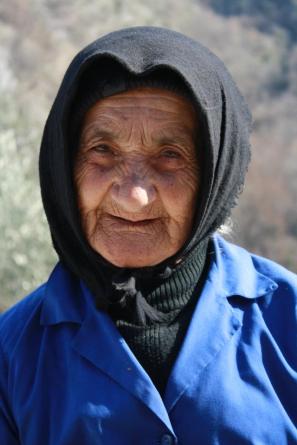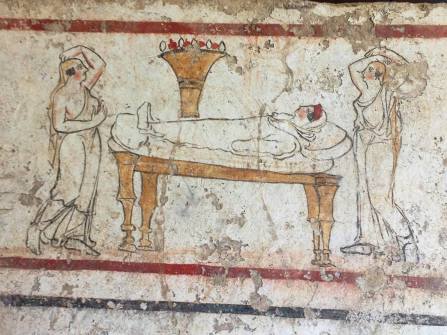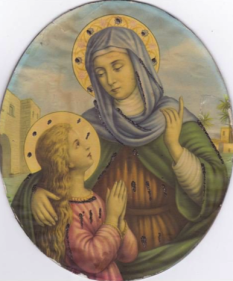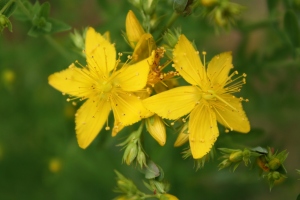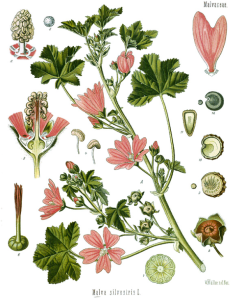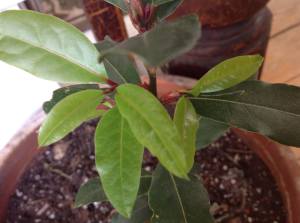Part One
In the remote mountain villages of Southern Italia, like ours, the old ways still thrive. We are a tribal culture, an indigenous people, descendants of the ancient Lucana Tribe; we are remembered as the People of the Sacred Wood, of the White Light. Our animal totems are the wolf and the deer. Our sacred traditions have been passed along orally, for many thousands of years.
We speak a variation of the Neapolitan dialect, use hand signals and glances, wear protective charms and amulets, and recite secret prayers that have been handed down through our family lines for generations. We pray with a string of beads called a rosary. We light candles when making offerings, petitions, prayers and blessings. We make novenas and pilgrimages in honor of our beloved saints. We walk together in seasonal processions, singing timeless chants, led by our parish priest. We use holy water and sacred salts to sanctify and cleanse. We anoint, heal and divine with olive oil, pressed from the fruit of our sacred tree of peace and use a multitude of plants to bless, consecrate, nourish and heal.
These ancient ways are our treasures. They are our inheritance. They vibrate with primordial truth and intensity and exist right beside, inside and outside of the rituals of the Catholic Church.
Benedicaria is a relatively new word, coined in the Americas, to describe the old ways of Southern Italia spiritual culture and tradition.
In the region of Campania, where our village is located, we refer to the old ways of healing, cleansing and religious devotion as Fa lu Santuccio, which literally means, “Do a little holy thing”. We call a practitioner of these traditional healing ways Benedetto if he is a male, or Benedetta if she is a female – both of which mean “Blessed One”. Most of the prayers used in Benedicaria are taken directly from Catholic prayer books.
Our Southern Italian family-based spiritual traditions are renowned for possessing a great deal of flexibility and fluidity. As a result, the practices found in Benedicaria vary from family to family and from individual to individual.
The primary role of the Italian Benedicaria practitioner is that of a community healer, both through the wise use of natural elements, and through spiritual healing. The former requires extensive knowledge of plants and herbs as well as substances obtained from animals and minerals. Spiritual healing is believed to come from an inner power, known as la forza (power), la virtù (virtue) or il Segno (the sign).
Practitioners of Benedicaria believe that they deal with spirit beings, both benevolent and malevolent. The later includes the unquiet dead as well as supernatural beings who are believed to cause harm to people. The benevolent beings include our ancestors, herbs, plants, trees, mountains, the elements, the helpful dead and our beloved saints, all of which we call upon to help defeat malevolent entities and physical illness.
The relationship between Stregoneria (witchcraft) and Benedicaria can be puzzling, but in their purest form the two are completely distinct. Many practitioners were raised with or taught elements of both traditions, so much so that it is often impossible to tell where one ends and the other begins.
The practitioner of Benedicaria is generally a devout Catholic who makes no pretensions of being a witch. Benedicaria is a comprehensive synthesis and evolution of spirituality, mysticism, and folk healing that took place among an indigenous people across many centuries.
Traditional medicine or folk healing comprises knowledge systems that developed over many generations within various societies before the era of modern medicine and pharmaceuticals. The World Health Organization (WHO) defines traditional medicine as “the sum total of the knowledge, skills, and practices based on the theories, beliefs, and experiences indigenous to different cultures, whether explicable or not, used in the maintenance of health as well as in the prevention, diagnosis, improvement or treatment of physical and mental illness”. In the written record, the study of herbs dates back for at least 5,000 years to the ancient Sumerians who described already well-established medicinal uses for plants.
Indigenous medicine is generally transmitted orally through a community, family and individuals until it is “collected”. Within a given culture, elements of indigenous medicine knowledge may be diffusely known by many, or may be gathered and applied by those in a specific role of healer such as a Benedetta, shaman, witch or midwife.
Three factors legitimize the role of the healer – their own beliefs, the success of their actions and the beliefs of the community.
Traditional Herbal Use – In Southern Italian folk medicine, plants are believed to posses a spiritual consciousness, what we refer to as the numen or the genii. They are gathered with great respect for the genius loci from which they come. It is this consciousness that lends its power to, and is responsible for healings, blessings and what we might speak of as plant magic. Many plants and trees are associated with saints for this reason. Not only are they thought to signify or represent the saint, but in many cases are considered to actually be the saint in plant form.
For instance, Matricaria (literally meaning dear or devoted mother) is associated with Sant Anna, (Saint Ann) the mother of Mary. Sant Anna is the patroness of our village; her shrine sits on a hilltop overlooking the housetops and it is she that we pray to for all issues regarding fertility, pregnancy, childbirth and matters involving the family.
Antibiotic garlic, well known to protect against a myriad of infectious diseases, is seen as San Michele (St. Michael) the protective warrior incarnate, able and willing to go to battle to defend us. My mother told me how, as a little girl, she was sent to school wearing a clove of garlic hung around her neck for protection whenever colds and especially the flu were rampant.
Hypericum is the healing spirit of San Giovanni, (Saint John the Baptist) whose feast day is celebrated at the summer solstice, when the light of the sun is at its peak. Plants gathered on the eve of his feast day, June 23, are hung in the house for the rest of the year as protection against malevolent forces.
Rosa, the quintessential flower of love long associated with Isis, Venus and Aphrodite, is the emblem of Blessed Mother Mary, Mother of God, and imparts her beneficent, healing energy.
What follows is a brief description of a number of common herbs and trees that are commonly used to bless, protect and promote healing in my region of Southern Italia. This information has been gathered directly from elder people in my village and the surrounding area, from my own personal experience and research over many years and from a recently conducted academic study done by local botanists, entitled Traditional Plant Use in the National Park of Cilento and Vallo di Diano, Campania, Southern Italy, by Riccardo Di Novella, Nicola Di Novella, Laura De Martino, Emilia Mancini, and Vincenzo De Feo, published in the Journal of Ethnopharmacology.
Marshmallow – Althea officinalis, called Rosa ri li fuossi and A. sylvestris is known as malva (Malvaceae). Common mallow is an herbaceous species common throughout Southern Italia and is one of the most important medicinal species in our folk pharmacopoeia. Its use as a panacea is made clear by a local saying, La malva, da ogni mal’ ti salva, (the common mallow saves you from every disease). The aerial parts of the mallows, prepared as an infusion or decoction, are often used for their restorative properties to treat cold, flu, stomach ache and colic, for the relief of menstrual cramps and as a post-partum depurative. These plants are also used topically to relieve toothache due to dental abscess or decay, to soothe heat and diaper rash, to heal bruises and help drain boils and abscess, and against mastitis. They are also commonly used to treat a number of SSTIs, (skin and soft tissue infections), most of which are typically associated with bacterial infection. In veterinary care, a decoction prepared with mallow and aerial parts of nettle is administered after cow dropping.
Horehound – Marrubium vulgare called maruggē and mentastro (Lamiaceae). White horehound is a perennial herb native to Europe, northern Africa, and temperate Asia. Much like common mallow, white horehound is also an extremely important species in the folk pharmacopoeia of southern Italy. It, too, is considered a panacea and is associated with the following saying, A maruggē, ognē malē struggē (the white horehound destroys every disease). White horehound decoctions are used as an expectorant, hepatoprotective agent, and cure-all. A decoction of the aerial parts is used as a wash to treat several SSTIs, including general dermatitis, athlete’s foot, boils and abscess, cysts and warts in both humans and animals.
Chamomile – Matricaria recutita known as Hammamilla (Asteraceae). German chamomile grows throughout our area and is best known for its anxiolytic and sedative properties. The leaves and flowers are commonly used as a relaxant and a sleep aid, as a wash for skin conditions such as rash, as a treatment for acne and dermatitis and also as an eyewash for conjunctivitis. A simple tea is consumed to soothe the stomach and allay nausea. My grandmother, Maria Giuseppa Cammarano Quagliozzi, taught me that chamomile is a “cure-all” and she offered a cup of its tea to ease headache, relieve menstrual cramps and to settle upset feelings. The aerial parts are also used as a yellow dye.
Olive – Olea Europa known as Auliva (Oleaceae). The olive is a relatively small evergreen tree that is extremely long lived and a native of the Mediterranean region. It has long been a symbol of endurance, wisdom and peace. It is believed to be the branch that was carried back to Noah’s ark after the flood and because of this is considered to speak of the renewal of life. The olive is considered a sacred tree that unites humans with the divine. Minerva taught that the oil pressed from its fruit could be burned as an offering in lamps as an act of reverence and devotion. Jesus conducted many of his sermons in the Mount of Olives, which was a sacred olive grove, and the burial grounds for many of his ancestors. On Holy Thursday Catholics participate in a special morning mass during which olive oil is consecrated. This sacred oil, called chrism, is often blended with other aromatics, such as sweet smelling balsam or rose oil, and used during the rest of the year as an integral part of sacramental rites; for Anointing the Sick, Reconciliation, Holy Orders, Baptism and Confirmation. Olive oil has been used to anoint people, places, tools and sacred objects for thousands of years and its use for ceremony, healings and blessings stretches back for millennia. Among the people of Southern Italia it remains the preferred oil for extracting the medicinal properties of plants and also for cooking. 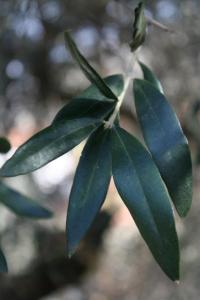
The fresh leaves are prepared as a decoction to moderate high blood pressure. Modern science confirms this use and also tells us that olive leaves possess strong antimicrobial properties. In my experience olive leaves are fast acting and effective when used to counter infection. My friend Antonietta told me that her mother would burn olive leaves and use the ash topically to cure skin infections. In Southern Italia we fill jars with freshly gathered St. John’s wort leaves and flowers, called erva ri’ San Giuvanno and erva ri li mahari, cover the plant with olive oil, then place it in the sun to steep for several weeks. This oil is used topically to relieve many types of aches and pains and also as a protective anointing oil when someone is passing from this life into the next.
Bay Leaves Laurus nobilis L. called Lauro and Alloro (Lauraceae). The bay tree is a lovely evergreen tree native to the Mediterranean. A decoction of the leaves is used as a gastric antispasmodic and for the relief of menstrual cramps. The leaves are made into a digestif, which is taken after meals to assist digestion. Analgesic bay leaves are infused in olive oil and applied topically for the relief of aches and pains. The fruits are heated in olive oil and used in the topical treatment of auricular inflammations, earache. The bay tree has a long history of magical/mystical use. The Sibyls burned the leaves as an incense to enhance trance and their ability to prophesize.
Rue – Ruta graveolens called a’ruta (Rutaceae). This plant is a hardy evergreen perennial, native to Italia and Southern Europe. Referred to as the Herb of Grace, it has long been used to sprinkle holy water and as an integral element in sacred ceremony. A sprig of rue has traditionally been carried in a little bag or worn around the neck for protection. Sometimes it is combined with a clove of garlic or a pinch of salt. One of my favorite home made charms combines a sprig of rue, a little pinch of ash from the hearth, and a bit of hair from each family member, all kept together in a little red bag and hung in the home to bless and protect each member of the family. Rue is a potent antispasmodic, an emmenogogue and possesses strong analgesic properties. It is infused in olive oil and applied topically as a rub for sore muscles and to relieve aches and pains. The leaves of rue and fruits of Capsicum annum are typically simmered together in olive oil; this preparation is applied topically as an antirheumatic.
Rosemary – Rosmarinis officinalis called rosmarina (Lamiaceae). Highly regarded as an herb of protection, rosemary grows wildly all throughout our area, both inland in the mountains and along the seacoast. It is one of the most widely used spices in Mediterranean cooking, especially with meat dishes, and is considered a cure-all. Around my village it is planted at the entrance to a home or garden as protection against negativity and harm. A sprig is often burned as incense to clear the air and at night before bed to protect against disturbing dreams.
Poppy Papaver rhoeas known as Papavero and papapiro (Papaveraceae). The red petals are mucilaginous, bitter and expectorant and commonly prepared as a syrup that is used to alleviate cough and hoarseness and soothe a sore throat. Papavero is regarded as pain relieving, sedative, calming, and trance inducing and is sometimes enjoyed as a cordial. P. rhoeas has a long association with wheat and the combination of the two is traditionally used as an entheogen. The red flowers thrive wildly and abundantly amidst the wheat fields here as they have for thousands of years. Their species name is Italian and comes from Rhea, the name given to the mother of the founders of Rome, Romulus and Remus. It was also a name attributed to Cybele, the Anatolian mother-goddess celebrated as Ceres among the Italic tribes. Ceres was known as Demeter among the Greeks and was the Goddess of Grain. Ancient legends tell us of Rhea (imagine red poppies here) descending on the plains near the Elysian Fields in order to console Demeter/Ceres (wheat) after Persephone/Proserpina was lost, and together they bring fertility and growth back to the earth. Ceres was often depicted holding both poppies and wheat in her hands. She was revered as the very ground from which the crops sprung. Later on, as Christianity spread through these lands, Ceres became Mary.
This is an abbreviated version of the presentation I gave at the Viridis Genii Symposium at the Still Meadow Retreat Center, in Damascus, Oregon, in July of 2015. For the full print version see Verdant Gnosis: Cultivating the Green Path, published by Rubedo Press.

